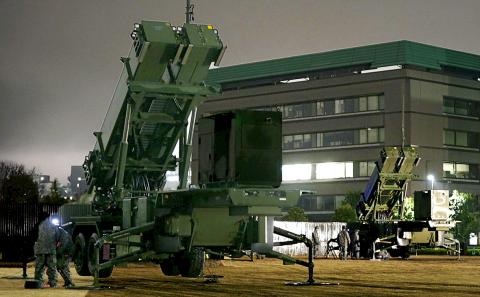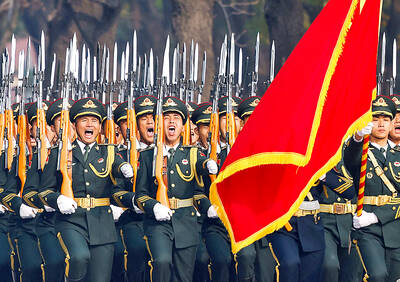Japan has put its military on alert for a possible North Korean ballistic missile launch after indications that Pyongyang is preparing for a test firing, two people with direct knowledge of the order said yesterday.
“Increased activity at North Korea’s missile site suggests that there may be a launch in the next few weeks,” said one of the sources, both of whom declined to be identified, because they are not authorized to talk to the media.
Tension rose in East Asia this month after North Korea’s fourth nuclear test, this time of what it said was a hydrogen bomb.

Photo: Reuters
A missile test coming so soon after the nuclear test would raise concerns that North Korea plans to fit nuclear warheads on its missiles, giving it the capability to launch a strike against South Korea, Japan and possibly targets as far away as the US west coast.
Japanese Minister of Defense Gen Nakatani has ordered Aegis destroyers that operate in the Sea of Japan to be ready to target any North Korean projectiles heading for Japan, the sources said.
A Ministry of Defense spokesman declined to say whether MIM-104 PAC-3 Patriot missile batteries and the Aegis destroyers had been deployed to respond to any threat from North Korea
The advanced Aegis vessels are able to track multiple targets and are armed with SM-3 missiles designed to destroy incoming warheads in space before they re-enter the atmosphere and fall to their targets.
Japan also has Patriot missile batteries around Tokyo and other sites to provide a last line of defense as warheads near the ground.
However, rather than a direct attack, Japan is more concerned that debris from a missile test could fall on its territory.
Meanwhile, South Korea yesterday indicated an increased willingness to host an advanced US anti-missile defense system as the activity detected at the North’s missile site revived talk of deploying a system opposed by China and Russia.
US military officials have said the sophisticated system, called the Terminal High Altitude Area Defense (THAAD), was needed in South Korea, which faces the threat of an increasingly advanced North Korean missile program.
“If THAAD is deployed by the US military in [South] Korea, it will be helpful for our security and defense,” South Korean Ministry of National Defense spokesman Kim Min-seok said.
Previously, South Korea was reluctant to openly discuss the possibility of the deployment, as it tried to walk a fine line between its closest ally, the US, and its biggest trade partner, China.
The US maintains 28,500 military personnel in the country, a legacy of the 1950-1953 Korean War, which ended in a truce and left the two Koreas in a technical state of war.
China is North Korea’s major ally, but in recent years South Korea has forged increasingly strong ties with China.
“We believe that any country, when striving for its own security, should also consider other countries’ security interests and regional peace and stability,” Chinese Ministry of Foreign Affairs spokeswoman Hua Chunying (華春瑩) told a briefing when asked about the possibility of THAAD being deployed in South Korea.
The system has radar that can track multiple ballistic missiles up to 2,000km away, a range which would reach deep into China and Russia.
THAAD is built by Lockheed Martin, and costs an estimated US$829.2 million apiece. Some THAAD opponents in South Korea instead propose developing an indigenous missile defense system.
China and Russia, which are among the five international powers that have sought to negotiate with the North to persuade it to abandon its nuclear weapons, have spoken against stationing the THAAD system in South Korea.

The Ministry of Foreign Affairs (MOFA) yesterday said it is closely monitoring developments in Venezuela, and would continue to cooperate with democratic allies and work together for regional and global security, stability, and prosperity. The remarks came after the US on Saturday launched a series of airstrikes in Venezuela and kidnapped Venezuelan President Nicolas Maduro, who was later flown to New York along with his wife. The pair face US charges related to drug trafficking and alleged cooperation with gangs designated as terrorist organizations. Maduro has denied the allegations. The ministry said that it is closely monitoring the political and economic situation

Conflict with Taiwan could leave China with “massive economic disruption, catastrophic military losses, significant social unrest, and devastating sanctions,” a US think tank said in a report released on Monday. The German Marshall Fund released a report titled If China Attacks Taiwan: The Consequences for China of “Minor Conflict” and “Major War” Scenarios. The report details the “massive” economic, military, social and international costs to China in the event of a minor conflict or major war with Taiwan, estimating that the Chinese People’s Liberation Army (PLA) could sustain losses of more than half of its active-duty ground forces, including 100,000 troops. Understanding Chinese

UNRELENTING: China attempted cyberattacks on Taiwan’s critical infrastructure 2.63 million times per day last year, up from 1.23 million in 2023, the NSB said China’s cyberarmy has long engaged in cyberattacks against Taiwan’s critical infrastructure, employing diverse and evolving tactics, the National Security Bureau (NSB) said yesterday, adding that cyberattacks on critical energy infrastructure last year increased 10-fold compared with the previous year. The NSB yesterday released a report titled Analysis on China’s Cyber Threats to Taiwan’s Critical Infrastructure in 2025, outlining the number of cyberattacks, major tactics and hacker groups. Taiwan’s national intelligence community identified a large number of cybersecurity incidents last year, the bureau said in a statement. China’s cyberarmy last year launched an average of 2.63 million intrusion attempts per day targeting Taiwan’s critical

‘SLICING METHOD’: In the event of a blockade, the China Coast Guard would intercept Taiwanese ships while its navy would seek to deter foreign intervention China’s military drills around Taiwan this week signaled potential strategies to cut the nation off from energy supplies and foreign military assistance, a US think tank report said. The Chinese People’s Liberation Army (PLA) conducted what it called “Justice Mission 2025” exercises from Monday to Tuesday in five maritime zones and airspace around Taiwan, calling them a warning to “Taiwanese independence” forces. In a report released on Wednesday, the Institute for the Study of War said the exercises effectively simulated blocking shipping routes to major port cities, including Kaohsiung, Keelung and Hualien. Taiwan would be highly vulnerable under such a blockade, because it